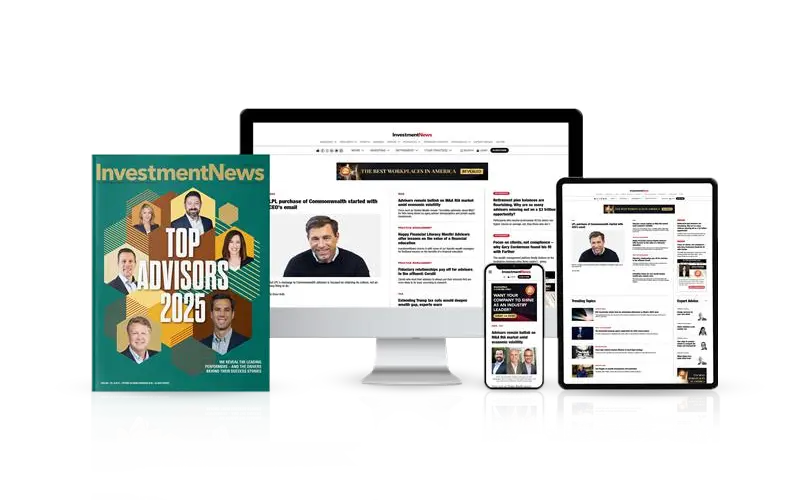

Some predict that AI could surpass the limits of human intelligence in just a few years – and whether that is intriguing, frightening, or confusing, the last thing financial advisors should do is ignore it.
The tools that are available now from large-language model assistants such as Open AI’s ChatGPT and Anthropic’s Claude already have massive implications for workflows on a scale that is yet to be fully understood.
And, importantly, many people are already experimenting with them in a work capacity, according to people who are at the forefront of AI research.
“Within your company, people are using AI that is not approved by your business,” said Allie Miller, an artificial intelligence investor who has led AI programs at two of the biggest cloud providers, speaking recently at Charles Schwab’s Impact conference.
As many as half of those working at financial service companies are using AI in some way, she said.
Rather than trying to clamp down on that, it’s important for organizations to be open to policies that let people use AI, said Ethan Mollick, associate professor at the Wharton School of the University of Pennsylvania, speaking on the same panel.
“People in your organization are already doing this to automate responsibilities, because no one is telling them not to.… Realistically, ‘shadow’ AI use is ubiquitous at your company,” he said to the RIA audience. “Don’t make the general counsel’s office [the place] where this dies.”
Generative AI is imperfect. Some of the results people get after submitting prompts lead to what those in the area call hallucinations – what are essentially fabricated details in the assistant’s response. Recognizing that hallucinations are common – and learning how to spot them – is critical if a company wants to use AI in some capacity, researchers said.
Gaining aptitude for that comes with experience, as does expertise in submitting prompts that lead to the results people want. Setting aside a few hours a week just to experiment with generative AI is the only way to develop that expertise, panelists said.
“Assume that it is lying a certain percentage of the time, and train your people to verify the information,” Miller said. “Testing it, always in a domain in which you’re an expert, is a great place to start.”
Even with hallucinations and error rates, the tradeoffs are worth it; “It can make your workflow more robust and more creative,” she said. Someone can ask an AI assistant to provide an idea on a topic – and then ask it to provide 10 times more, for example.
“If you’re not getting surprising stuff, it’s probably on you.”
When approaching AI, think about using it for ancillary tasks, Mollick said. It can be helpful for client communications that do not involve private or sensitive data, for example. It can also provide a second opinion or analyze an annual report – just don’t trust it for investing decisions yet.
“When you give generative AI a task, it’s like giving a task to a smart human,” Mollick said.
Others compared it to an Ivy League grad student, capable of handling many tasks but still requiring double-checking.
“You just need 10 hours of use to get good at this,” Mollick said of learning how to use prompts that get good results. “It really is not that hard … I would go with Claude or ChatGPT to get started.”
AI is also a good “red teamer” that can find holes or weaknesses in arguments, said another researcher on the panel, David Edelman, founder and director of the MIT Project on Technology, the Economy, and National Security.
“It’s helping us surface our own biases,” he said.
While it is still early, large language models can already assess financial statements more accurately than human analysts, a paper earlier this year from the University of Chicago Booth School of Business found. Using ChatGPT, researchers were able to predict earnings changes with more precision than financial analysts, suggesting that the technologies may soon play more of a role in decision-making.
Financial advisors are indeed using generative AI to help with scheduling, taking notes in meetings, and preparing for events, they say.
“My calendar app is the most empowering of all the AI I use. I used to spend quite a lot of time reshuffling my tasks when new meetings were scheduled, meetings were canceled, new client tasks emerged, etc. This app automatically updates my calendar as appointments change or tasks are added,” said Amy King, founder of Instar Financial Planning, in an email. “It makes a huge difference in productivity.”
It’s also been valuable for comparing insurance plans, drafting initial financial plans, and generating baseline research documents, she said. But she also cautions others about AI’s potential dangers and shortcomings.
“Assume the information you share with AI will be shared worldwide. If it’s not OK to share it, don’t let AI have it,” she said. “Assume there are mistakes in the work. Review and fact-check before basing any recommendation or work on an AI-generated product.”
And any deliverables to clients and prospects should be in the advisor’s voice – not the chatbot’s, she said.
In addition to note taking and doing meeting recaps, AI has been useful for going over documents, said Zack Gutches, founder of True Riches Financial Planning.
“Certain digital estate-planning tools are also using AI to read and summarize estate-planning documents like wills and trusts, which saves a ton of time,” he said in an email.
Some are experimenting with it outside of workflows, such as Nick Rygiel, who has tasked large language models with coding for his firm’s website and for a separate site dedicated to educational resources for digital asset advisory services.
“Working with AI/coding helps me better understand and experience firsthand the capabilities that exist today and how AI agents function,” Rygiel, owner of Ironclad Financial, said in an email.
For the uninitiated, it will pay to start using it sooner rather than later, Mollick said.
“If you haven’t downloaded it, do it and start using it this week. Get your 10 hours in.…This is not abstract anymore. It’s a real thing,” he said. “We have control over it.… Figure out what this is and how it can work for you.”

By listening for what truly matters and where clients want to make a difference, advisors can avoid politics and help build more personal strategies.

JPMorgan and RBC have also welcomed ex-UBS advisors in Texas, while Steward Partners and SpirePoint make new additions in the Sun Belt.

Counsel representing Lisa Cook argued the president's pattern of publicly blasting the Fed calls the foundation for her firing into question.

The two firms violated the Advisers Act and Reg BI by making misleading statements and failing to disclose conflicts to retail and retirement plan investors, according to the regulator.

Elsewhere, two breakaway teams from Morgan Stanley and Merrill unite to form a $2 billion RIA, while a Texas-based independent merges with a Bay Area advisory practice.
Orion's Tom Wilson on delivering coordinated, high-touch service in a world where returns alone no longer set you apart.
Barely a decade old, registered index-linked annuities have quickly surged in popularity, thanks to their unique blend of protection and growth potential—an appealing option for investors looking to chart a steadier course through today's choppy market waters, says Myles Lambert, Brighthouse Financial.
